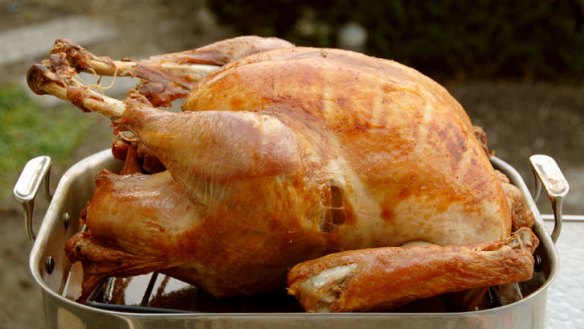The trouble with turkey

How do I cook the Christmas turkey so it doesn't end up dry? A. Garfield
You could consider one of the ''fresh whole'' turkeys you can find in supermarkets that contain 94 per cent turkey. Fancy that! The other 6 per cent is made up of diphosphates, polyphosphates, guar gum, xanthan gum, canola oil and sugar. Merry Christmas. Esteemed British food writer Matthew Fort gives a method that cooks the bird at 61C-63C for 10 hours, then finishes it with a blast of heat to brown the skin. Most ovens can't deliver such low temperatures accurately so it's not something I would recommend. The best turkey I ever had was cooked by my mate Macca. He took a free-range bird, not too big, and brined it a brine made with five litres of water, two cups of grey sea salt and a cup of raw sugar with half a dozen bay leaves, a small handful of fresh thyme and six crushed juniper berries, which he simmered for 15 minutes and allowed to cool before putting in his turkey and keeping it overnight in the fridge. He roasted it in the usual manner. It was brilliant.
goodfood.com.au recipes
Brined and roasted turkey with cornbread stuffing
Roast turkey with ricotta stuffing
Roast turkey roll with Chinese pork and prawn stuffing
Turkey roll with chorizo and preserved lemon
What is kelp salt and where can I get it? J. Anderson
This is the chicken salt of the foodies' world, salty and full of umami yumminess. It is made with ground particles of kelp, which are fine enough to remain dispersed through the salt. Kelp is one of the most glutamate-rich foods on the planet, with a whopping 2200 milligrams per 100 grams of this yummy tasting amino acid. If you can't find kelp salt, you can make your own by toasting a sheet of dry nori seaweed, as is used in making sushi, in a low oven until dry and crisp. Pulverise in a mortar and pestle, and blend through half a cup of salt. Alternatively, you can buy Mount Zero's version online at mountzeroolives.com. Or try chicken salt made with salt, chicken extract, hydrolysed soy protein and buckets of MSG.
I want to make bread. What sort of flour should I use? L. Wallace
You are about to embark on a wonderful journey, my friend. There is an overwhelming sense of self-satisfaction when feeding the family with a loaf baked by one's own hands. Making bread requires high-protein flour, about 12 per cent. The proteins in wheat protein join together when you add water and knead the bread to form long elastic strands. As the yeasts in dough eat the sugars, they belch out carbon dioxide. The elastic strands of protein not only trap the gas but allow the dough to expand at the same time, holding its shape. Finally, the protein bakes hard and crisp in the oven, giving you a lovely crust. You can find the percentage of protein in the nutrition panel on the side of the packet. Some supermarkets have given up on stocking bread-flour, preferring to sell pre-mixed preparations. But you should have some luck if you look out for Wallaby and Defiance brands in five-kilogram bags and Lighthouse in three-kilogram boxes in larger supermarkets.
Send your queries to brainfood@richardcornish.com.au or leave a question for him in the comments below.
The best recipes from Australia's leading chefs straight to your inbox.
Sign up- More:
- Brain food
